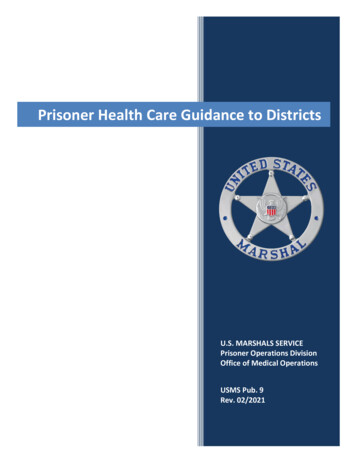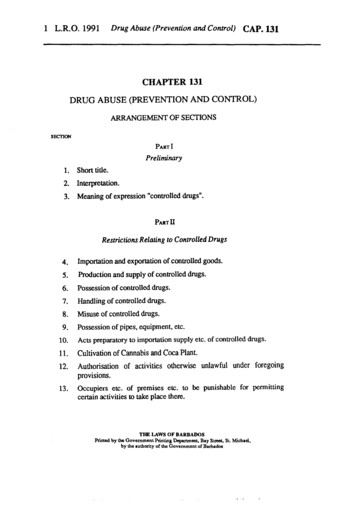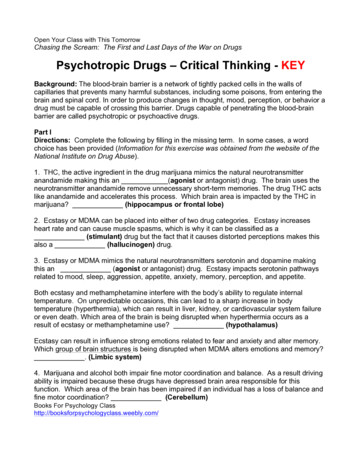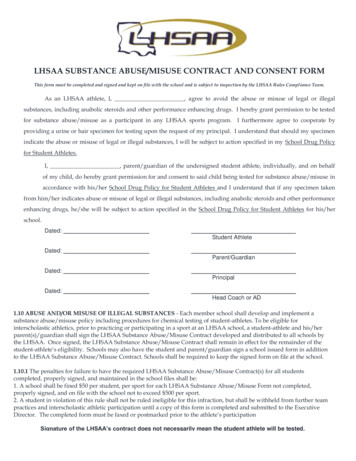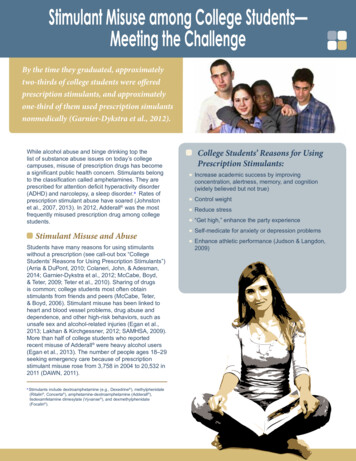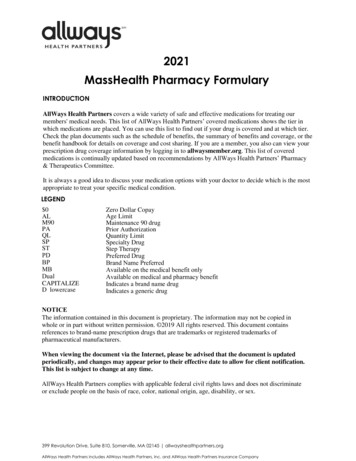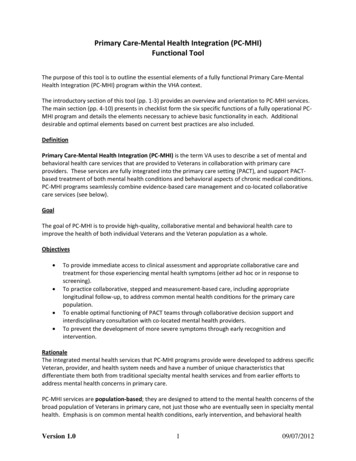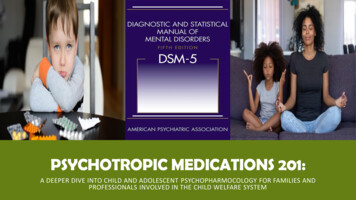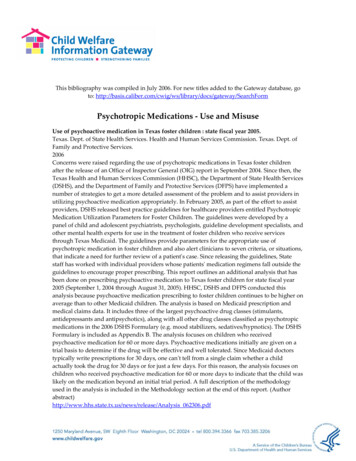
Transcription
This bibliography was compiled in July 2006. For new titles added to the Gateway database, goto: way/SearchFormPsychotropic Medications - Use and MisuseUse of psychoactive medication in Texas foster children : state fiscal year 2005.Texas. Dept. of State Health Services. Health and Human Services Commission. Texas. Dept. ofFamily and Protective Services.2006Concerns were raised regarding the use of psychotropic medications in Texas foster childrenafter the release of an Office of Inspector General (OIG) report in September 2004. Since then, theTexas Health and Human Services Commission (HHSC), the Department of State Health Services(DSHS), and the Department of Family and Protective Services (DFPS) have implemented anumber of strategies to get a more detailed assessment of the problem and to assist providers inutilizing psychoactive medication appropriately. In February 2005, as part of the effort to assistproviders, DSHS released best practice guidelines for healthcare providers entitled PsychotropicMedication Utilization Parameters for Foster Children. The guidelines were developed by apanel of child and adolescent psychiatrists, psychologists, guideline development specialists, andother mental health experts for use in the treatment of foster children who receive servicesthrough Texas Medicaid. The guidelines provide parameters for the appropriate use ofpsychotropic medication in foster children and also alert clinicians to seven criteria, or situations,that indicate a need for further review of a patientʹs case. Since releasing the guidelines, Statestaff has worked with individual providers whose patientsʹ medication regimens fall outside theguidelines to encourage proper prescribing. This report outlines an additional analysis that hasbeen done on prescribing psychoactive medication to Texas foster children for state fiscal year2005 (September 1, 2004 through August 31, 2005). HHSC, DSHS and DFPS conducted thisanalysis because psychoactive medication prescribing to foster children continues to be higher onaverage than to other Medicaid children. The analysis is based on Medicaid prescription andmedical claims data. It includes three of the largest psychoactive drug classes (stimulants,antidepressants and antipsychotics), along with all other drug classes classified as psychotropicmedications in the 2006 DSHS Formulary (e.g. mood stabilizers, sedatives/hypnotics). The DSHSFormulary is included as Appendix B. The analysis focuses on children who receivedpsychoactive medication for 60 or more days. Psychoactive medications initially are given on atrial basis to determine if the drug will be effective and well tolerated. Since Medicaid doctorstypically write prescriptions for 30 days, one canʹt tell from a single claim whether a childactually took the drug for 30 days or for just a few days. For this reason, the analysis focuses onchildren who received psychoactive medication for 60 or more days to indicate that the child waslikely on the medication beyond an initial trial period. A full description of the methodologyused in the analysis is included in the Methodology section at the end of this report. lease/Analysis 062306.pdf
Helping parents, youth, and teachers understand medications for behavioral and emotionalproblems : a resource book of medication information handouts. 3rd ed.Dulcan, Mina K. Cummins, Thomas, M.D.2006American Psychiatric Pub.Abstract unavailable.Should you medicate your childʹs mind? : a child psychiatrist makes sense of whether to givekids psychiatric medication.Roberts, Elizabeth J., 19582006Marlowe & Co.Abstract unavailable.Multiple psychotropic medication use for youths : a two-state comparison.dosReis, Susan. Zito, Julie M. Safer,Daniel J. Gardner, James F. Puccia, Karen B. Owens, PamelaL.Johns Hopkins Medicine.2005Journal of Child and Adolescent Psychopharmacology15 (1) p. 68-77Available from: Mary Ann Liebert, Inc. publishers140 Huguenot Street, 3rd FloorNew Rochelle, NY 10801-5215Tel: 914- 740-2100 1-800-M-LIEBERTAvailable from: http://www.liebertpub.com/The aim of this study was to compare multiple psychotropic use among youths enrolled in twoU.S. mid-Atlantic state Medicaid and state Childrenʹs Health Insurance Programs (SCHIP).Administrative data were used to examine multiple psychotropic use among youths less than 20years of age and who were continuously enrolled in Medicaid or SCHIP programs in two statesduring 1999. Multiple psychotropic use referred to multiclass combinations and was defined bythe number of months of multiple use. Main outcome measures were the prevalence of multiplepsychotropic use and months of multiple use. Demographic and clinical characteristics, mentalhealth visits, and common combinations were examined according to months of multiple use.Among continuously enrolled youths, 21%-22% had at least one mental health-related visit, 8%10% received a psychotropic medication, and 2%-3% received multiple psychotropicmedications. Nearly one third (28%-30%) of youths with any psychotropic use received multiplemedications, of which almost half was for 5-12 months. Multiclass use was more common inmale, white, aged 10-14, disabled, and foster-care youths. Stimulants with antidepressants,antipsychotics, or alpha-agonists were the most common combinations. Multiple use occurred innearly one third of youths with any psychotropic treatment. Additional research is needed to2
investigate switching patterns and the effectiveness of combined pharmacotherapy. (Authorabstract)Effect of Medicaid eligibility category on racial disparities in the use of psychotropicmedications among youths.Zito,Julie Magno. Safer, Daniel J. Zuckerman, Ilene H. Gardner, James F. Soeken, Karen.University of Maryland, Baltimore.2005Psychiatric services56 (2) p. 157-163Available from: American Psychiatric Association1000 Wilson Boulevard, Suite 1825Arlington, VA 22209-3901Tel: 703-907-7300apa@psych.orgAvailable from: http://www.psych.org/This study sought to determine the degree to which Medicaid eligibility categories modifydisparities between black and white youths in the prevalence of psychotropic medication.Computerized claims for 189,486 youths aged two to 19 years who were continuously enrolled ina mid-Atlantic state Medicaid program for the year 2000 were analyzed to determine populationbased annual prevalence of psychotropic medication by race or ethnicity and by whether theyouths were eligible for Medicaid for reasons of family income, disability, or foster careplacement. Logistic regression was used to assess the interaction of eligibility category and race.The mean annual prevalence of psychotropic medication for the population was 9.9 percent. Theprevalence was 2.17 times higher for white youths than for black youths (16.5 percent comparedwith 7.6 percent). However, within eligibility categories, the white-to-black disparity was 3.8among youths who were eligible for Medicaid because their family income was below the federalpoverty level and 3.2 for youths enrolled in the State Childrenʹs Health Insurance Program.Medicaid eligibility categories had a profound impact on the racial disparity associated with theprevalence of psychotropic medications for youths. Eligibility category should be taken intoaccount when ascertaining the role of access, undertreatment, and culture in disparities in mentalhealth treatment. (Author abstract)Psychotropic medication for children and adolescents.Malkin, Michael.2005Available from: National Association of Counsel for Children (NACC)1825 Marion Street, Suite 242Denver, CO 80218Tel: 1-888-828-NACCadvocate@NACCchildlaw.orgAvailable from: http://www.naccchildlaw.org3
Mental disorders can be thought of as the consequence of both psychological and organic factors.Psychological factors are such events as emotional traumas at critical times in oneʹs life. Organicfactors are abnormalities in the structure or functioning of the brain which result from geneticcontrol of the blueprint for the brain, interference with brain development (e.g., prenatal drug orviral effects) and interference with brain function from trauma, toxicity, infection, metabolicdisorders, etc. These factors interact; organic impairment causes increased vulnerability topsychological stress, and psychological stress exacerbates organic impairment. There is goodevidence that early childhood psychological stress can cause physical abnormalities in parts ofthe developing brain. And, physical impairment is often psychologically stressful. Someindividuals with mental disorders have relatively pure problems in one or the other of thesespheres, but most have problems in both, and proper treatment should reflect this complexity. Insome cases, psychotherapy is less effective, if not impossible, without the use of psychotropicmedication to correct underlying organic impairment, and, conversely, psychotherapy isgenerally an important adjunct to get the most benefit out of treatment with medication.Psychotropic medications are tools for producing certain chemical and physiological effects inthe central nervous system. As with other tools, their effects may be good or bad, depending onthe intentions and skills of those who use them. The best general indicator of whetherpsychotropic medication is being properly used is whether the patientʹs mental functioning isbetter with the medication than without it. Usually, the answer to this is clear, but, sometimes, itis not simple to determine. Mental functioning has numerous components (e.g. thinking,emotions, control of behavior and impulses, perception, control of physiological processes suchas sleeping and appetite etc.). Medications can have desirable effects on some aspects of mentalfunctioning and undesirable effects on others as well as effects on bodily functions havingnothing to do with the central nervous system. When the effects of medication are mixed (somedesired, some undesired) how can it be determined if the sum is good or bad? Is a good nightʹssleep and relief of depressed mood worth putting up with a dry mouth and constipation? Iseliminating hallucinations worth the risk of developing uncontrollable movements? Is the abilityto control assaultive impulses worth tolerating cognitive slowing and sedation? For a competentadult patient, this decision is up to the patient to make. For children or incompetent adults, theprocess of informed consent is more complex. Both the patient and the parent/guardian/judgehave a role in it. (Author abstract)http://www.naccchildlaw.org/pub/Psychmed 3-05.pdfPsychotropic medication utilization parameters for foster children.Texas Department of State Health rChildren.pdfAbstract unavailable.Medication of children and youth in foster care.Green, Diane L. Hawkins, Wesley. Hawkins, Michelle.4
Florida Atlantic University2005Journal of social work in disability and rehabilitation.p. 43-55.Publication Information: Binghamton, NY : The Haworth Press, Inc.Available from: The Haworth Press, Inc.10 Alice StreetBinghamton, NY 13904-1580Tel: 800-429-6784getinfo@haworthpress.comAvailable from: http://www.haworthpress.comThis study examined the type and frequency of prescribed medication of foster care youth in asouth Florida county during April, 2001. Using file reviews and structured interviews withtargeted case managers, it was found that 23% of the total sample (n 722) were currently usingmedication. Most frequent medications prescribed were Risperdal, Clonidine, Adderall, andRitalin. The majority of subjects had multiple prescriptions (57%) with no one pattern found formultiple prescribed drugs. The most frequent behaviors and symptoms found for thoseprescribed medication were sadness, delinquency history, and argumentative behavior.Approximately three-fourths of the youth had medications monitored, while the most frequentschedule of monitoring was monthly. The foster care placement was most likely to monitormedication while a psychiatrist did almost all prescribing. The most frequent placement wastherapeutic foster home while the most frequent Diagnostic and Statistical Manual diagnoseswere Attention Deficit Hyperactivity Disorder, Post Traumatic Stress Disorder, MajorDepression, and Bi-Polar Disorder. One most striking finding for mental health was that thosecurrently on medication were much more likely to have been Baker Acted (Florida law thatprovides a reasonable process for involuntarily committing those whose conduct makes themdangerous to themselves or others) than non-medication foster care youth. Finally, few barriersto services were found for the medication sample in receiving medication services.Psychotropic medication use in a national probability sample of children in the child welfaresystem.Raghavan, Ramesh. Zima, Bonnie T. Andersen, Ronald M. Leibowitz, Arleen A. Schuster, MarkA.University of California.2005Journal of child and adolescent psychopharmacology15 p. 97-106Publication Information: New Rochelle, NY: Mary Ann Liebert, Inc.Available from: Technology Partner - Atypon Systems, Inc.140 Huguenot StreetNew Rochelle, NY 10801-52155
Tel: 914) 740-2100Available from: http://www.liebertonline.com/loi/capThe aim of this study was to estimate the point prevalence of psychotropic medication use, andto describe relationships between child-level characteristics, provider type, and medication useamong children in the child welfare system. The National Survey of Child and Adolescent WellBeing is the first nationally representative study of children coming into contact with the childwelfare system. We used data from its baseline and 12-month follow-up waves, and conductedweighted bivariate analyses on a sample of 3114 children and adolescents, 87% of whom wereresiding in-home. Overall, 13.5% of children in child welfare were taking psychotropicmedications in 2001-2002. Older age, male gender, Caucasian race/ethnicity, history of physicalabuse, public insurance, and borderline scores on the internalizing and externalizing subscales ofthe Child Behavior Checklist were associated with higher proportions of medication use. AfricanAmerican and Latino ethnicities, and a history of neglect, were associated with lower proportionsof medication use. These national estimates suggest that children in child welfare settings arereceiving psychotropic medications at a rate between 2 and 3 times that of children treated in thecommunity. This suggests a need to further understand the prescribing of psychotropicmedications for child welfare children. (Author abstract)Psychotropic medication for children and adolescents.Malkin, Michael.2005Available from: National Association of Counsel for Children (NACC)1825 Marion Street, Suite 242Denver, CO 80218Tel: 1-888-828-NACCadvocate@NACCchildlaw.orgAvailable from: http://www.naccchildlaw.orgMental disorders can be thought of as the consequence of both psychological and organic factors.Psychological factors are such events as emotional traumas at critical times in oneʹs life. Organicfactors are abnormalities in the structure or functioning of the brain which result from geneticcontrol of the blueprint for the brain, interference with brain development (e.g., prenatal drug orviral effects) and interference with brain function from trauma, toxicity, infection, metabolicdisorders, etc. These factors interact; organic impairment causes increased vulnerability topsychological stress, and psychological stress exacerbates organic impairment. There is goodevidence that early childhood psychological stress can cause physical abnormalities in parts ofthe developing brain. And, physical impairment is often psychologically stressful. Someindividuals with mental disorders have relatively pure problems in one or the other of thesespheres, but most have problems in both, and proper treatment should reflect this complexity. Insome cases, psychotherapy is less effective, if not impossible, without the use of psychotropicmedication to correct underlying organic impairment, and, conversely, psychotherapy isgenerally an important adjunct to get the most benefit out of treatment with medication.6
Psychotropic medications are tools for producing certain chemical and physiological effects inthe central nervous system. As with other tools, their effects may be good or bad, depending onthe intentions and skills of those who use them. The best general indicator of whetherpsychotropic medication is being properly used is whether the patientʹs mental functioning isbetter with the medication than without it. Usually, the answer to this is clear, but, sometimes, itis not simple to determine. Mental functioning has numerous components (e.g. thinking,emotions, control of behavior and impulses, perception, control of physiological processes suchas sleeping and appetite etc.). Medications can have desirable effects on some aspects of mentalfunctioning and undesirable effects on others as well as effects on bodily functions havingnothing to do with the central nervous system. When the effects of medication are mixed (somedesired, some undesired) how can it be determined if the sum is good or bad? Is a good nightʹssleep and relief of depressed mood worth putting up with a dry mouth and constipation? Iseliminating hallucinations worth the risk of developing uncontrollable movements? Is the abilityto control assaultive impulses worth tolerating cognitive slowing and sedation? For a competentadult patient, this decision is up to the patient to make. For children or incompetent adults, theprocess of informed consent is more complex. Both the patient and the parent/guardian/judgehave a role in it. (Author abstract)http://www.naccchildlaw.org/pub/Psychmed 3-05.pdfState child welfare legislation 2004.National Conference of State Legislatures.2005Available from: National Conference of State Legislatures444 North Capitol Street NW Suite 515Washington, DC 20001Tel: 202-624-5400info@ncsl.orgAvailable from: http://www.ncsl.orgState law is an important part of the foundation of each stateʹs response to child maltreatment. Italso provides the legal framework for state legislatorsʹ oversight of the child welfare agenciesthat are charged with protecting childrenʹs safety and meeting their permanency and well-beingneeds. The National Conference of State Legislatures (NCSL) highlights state child welfarelegislation through its State Child Welfare Legislation reports. This report documents significantstate legislation enacted during calendar year 2004. A number of legislative trends that began inprevious years continued in 2004. These included new laws to address childrenʹs exposure tomethamphetamine, to improve educational services to children in the child welfare system, toexpedite permanency for foster children, to support foster parents and kinship caregivers, toassist youth who are aging out of care, and to promote collaboration among agencies that servechildren and families. A few areas received an unusual amount of legislative attention in 2004.Perhaps the most notable is a move to ensure that parentsʹ rights are protected when childwelfare agencies investigate. Many of these laws were passed to comply with recent amendments7
to the federal Child Abuse Prevention and Treatment Act, which require that subjects ofprotective investigations be informed of the allegations against them and that child protectiveservices (CPS) staff be trained in their legal duties to protect the legal rights and safety ofchildren and families. State legislation in 2004 also addressed the prescription of psychotropicmedication to children in custody, family involvement in case planning, and innovations in fostercare, such as whole family placements and ʺdedicatedʺ family homes. Descriptions of significantstate legislation appear below by issue area in alphabetical order. The appendix contains bothcitations and summaries of the laws discussed here. (Author 4.pdfEvidence-based therapies in child and adolescent psychiatry.Special reportMcClellan, Jon.CME, Inc. (Irvine, Calif.)2005Psychiatric times22 html pages 1-8Available from: CME2801 McGaw AvenueIrvine, CA 92614Tel: 800-993-2632 949-250-1008customer.service@cmellc.com.Available from: http://www.psychiatrictimes.comConsumer, professional, legislative and regulatory organizations are increasingly calling for thedevelopment and adoption of evidence-based therapies, based on demands for quality servicesand expectations that outpouring of dollars and time are rewarded by beneficial outcomes. Inchild and adolescent mental health, growing public concerns over safety, in particular withpsychotropic medications, and the recognition that psychiatric impairment is a major factorwithin other social service systems has further fueled the demand for empirically basedinterventions. Randomized, controlled trials (RCTs) with adequate sample sizes and definedstudy populations are the standard for characterizing an intervention as evidence-based(Cochrane Collaboration, 2002). A listing of all RCTs in child and adolescent psychiatry isbeyond the scope of this commentary (for a review, see McClellan and Werry [2003]). Thisreview will outline interventions with the best research support. Fortunately, although theliterature remains limited, the number of well-conducted studies is increasing. (Author le.jhtml?articleId 171201534Mental health medications for children : a primer.Guilford practical intervention in the schools series.Brown, Ronald T. Carpenter, Laura Arnstein. Simerly, Emily.20058
Guilford PressThis primer is designed specifically for school psychologists and other members of the schoolbased treatment team, as well as child clinical psychologists. The book provides information onpsychotropic medications that are frequently prescribed to manage childrenʹs behavior andenhance learning and academic performance. Effective guidelines are outlined for monitoringmedication use, documenting beneficial effects as well as adverse side effects, and facilitatingcollaboration among health care providers, teachers, and parents. Reproducible appendicesinclude tools for managing these essential tasks. (Author abstract)Representing Children, Families, and Agencies in Child Welfare, Juvenile Justice, Custody,and Adoption Proceedings, the 2004 Edition of the NACC Childrenʹs Law Manual Series.2004Denver, CO : National Association of Counsel for ChildrenNational Association of Counsel for Children1825 Marion Street, Suite 242Denver, CO 80218Tel: 1-888-828-NACC 303.864.5320advocate@NACCchildlaw.orgAvailable from: http://naccchildlaw.orgThe manual is 422 pages and includes 26 articles covering a wide range of childrenʹs legal issuesincluding: Interviewing Children with Disabilities; Youth with Sexual Behavioral Problems; Educational Advocacy; The Child as a Witness; Maintaining Sibling Bonds; Creating Youth PeerCourts; Confidentiality of Juvenile Mental Health Records; Psychotropic Medication; and more.Use of psychotropic medications by youths in therapeutic foster care and group homes.Breland-Noble, Alfiee M. Elbogen, Eric B. Farmer, Elizabeth M. Z. Dubs, Melanie S. Wagner, H.Ryan. Burns, Barbara J.Duke University Medical Center.2004Psychiatric services55 (6) p. 706-708Available from: American Psychiatric Association1000 Wilson Boulevard, Suite 1825Arlington, VA 22209-3901Tel: 703-907-7300apa@psych.orgAvailable from: http://www.psych.org/This article examines the use of psychotropic medications among youths in residentialcommunity based placements. Data are from a study funded by the National Institute of MentalHealth of therapeutic foster care (June 1999 through May 2001) and group homes (Januarythrough June 2001). Data were collected from staff by means of in-person interviews. Manyyouths in both settings received psychotropic medications, and approximately one-half were9
taking multiple psychotropic medications. After the authors controlled for demographic andclinical factors, the youths in group homes were nearly twice as likely as the youths intherapeutic foster care to receive medication. However, residential setting was not related topolypharmacology. Additional work is needed to study the appropriateness of use andimplications of such patterns for research on intervention outcomes. (Author abstract)Psychotropic drug use in foster care.Red Item ReportState of Florida. Florida Statewide Advocacy Council.2003Distributed by: Florida Statewide Advocacy Council4030 Esplanade Way Room 315-MTallahassee, FL 32399Tel: (850) 488-6173Available from: http://www.floridasac.org/This report highlights the findings of a study conducted by the Florida Statewide AdvisoryCouncil about the utilization of psychotropic medicines among foster children. A review of casefiles for 1,180 children living in therapeutic foster care revealed that more than half were takingat least one psychotropic medicine. The children taking psychotropic medicines were an averageof 12.7 years old and had been in care for approximately 11.5 months. Children not usingpsychotropic medicines were an average of 7.5 years old and had been in care about 5.5 months.Forty-four percent of the children taking psychotropic medicine had no record of a medicalevaluation and many did not have an identified psychiatric diagnosis. Proper consent formswere obtained for less than half of the children using psychotropic medicine. Thirty-eight percentof the case files had no documentation of consent and 15 percent had forms signed by anunauthorized person. Very few of the children were monitored for side effects of the drugs. TheStatewide Advisory Council recommends that the state initiate a quality assurance program tooversee the appropriateness of prescriptions for children after alternative interventions havebeen used. The state also should ensure that informed consent is obtained in writing with areview of benefits, risk, and other treatments. Finally, medical records must be kept nts/red psychotropic.docPsychotropic medication use among children in foster care : relationship to severe psychiatricdisorders.Zima, Bonnie T. Bussing, Regina. Crecelius, Gia M. Kaufman, Aaron. Belin, Thomas R.University of California - Los Angeles.1999American journal of public health89 (11) p. 1732-1735Available from: American Public Health Association800 I Street NWWashington, DC 20001-371010
Tel: 202/777-2516ajph.subscriptions@apha.orgThis study sought to describe the level of psychotropic medication use and its relationship tosevere psychiatric disorders among school-aged children in foster care. Home interviews with302 foster parents and children aged 6 to 12 years and 266 follow-up clinical evaluations wereconducted. Thirteen percent of the children had taken psychotropic medication in the previousyear, and 52% of those whose clinical status merited a medication evaluation had not receivedmedication in the previous year. As the efficacy of psychotropic medication treatment for severechild psychiatric disorders becomes more established, research on the appropriateness of suchcare can begin. (Author abstract)11
Concerns were raised regarding the use of psychotropic medications in Texas foster children . 3rd Floor New Rochelle, NY 10801-5215 Tel: 914- 740-2100 1-800-M-LIEBERT . Publication Information: Binghamton, NY : The Haworth Press, Inc. Available from: The Haworth Press, Inc. 10 Alice Street Binghamton, NY 13904-1580
